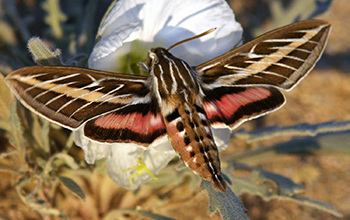Multimedia Gallery
White-lined sphinx (Hyles lineata) pollinating a pale evening primrose flower
Nighttime pollinators like the white-lined sphinx (Hyles lineata), seen here pollinating a pale evening primrose flower, rely on scent-based cues to locate flowers. Researchers discovered that nighttime pollution creates a chain of chemical reactions that degrades scent cues, leaving flowers like the evening primrose undetectable by smell.
[Research supported by U.S. National Science Foundation grants IOS 2121935 and AGS 2202287.]
Learn more in the University of Washington news story Novel 4D printing method blossoms from botanical inspiration. (Date of image: 2022; date originally posted to NSF Multimedia Gallery: May 3, 2024)
Credit: Courtesy of Ron Wolf
Images and other media in the National Science Foundation Multimedia Gallery are available for use in print and electronic material by NSF employees, members of the media, university staff, teachers and the general public. All media in the gallery are intended for personal, educational and nonprofit/non-commercial use only.
Images credited to the National Science Foundation, a federal agency, are in the public domain. The images were created by employees of the United States Government as part of their official duties or prepared by contractors as "works for hire" for NSF. You may freely use NSF-credited images and, at your discretion, credit NSF with a "Courtesy: National Science Foundation" notation.
Additional information about general usage can be found in Conditions.
Also Available:
Download the high-resolution JPG version of the image. (3.8 MB)
Use your mouse to right-click (Mac users may need to Ctrl-click) the link above and choose the option that will save the file or target to your computer.

